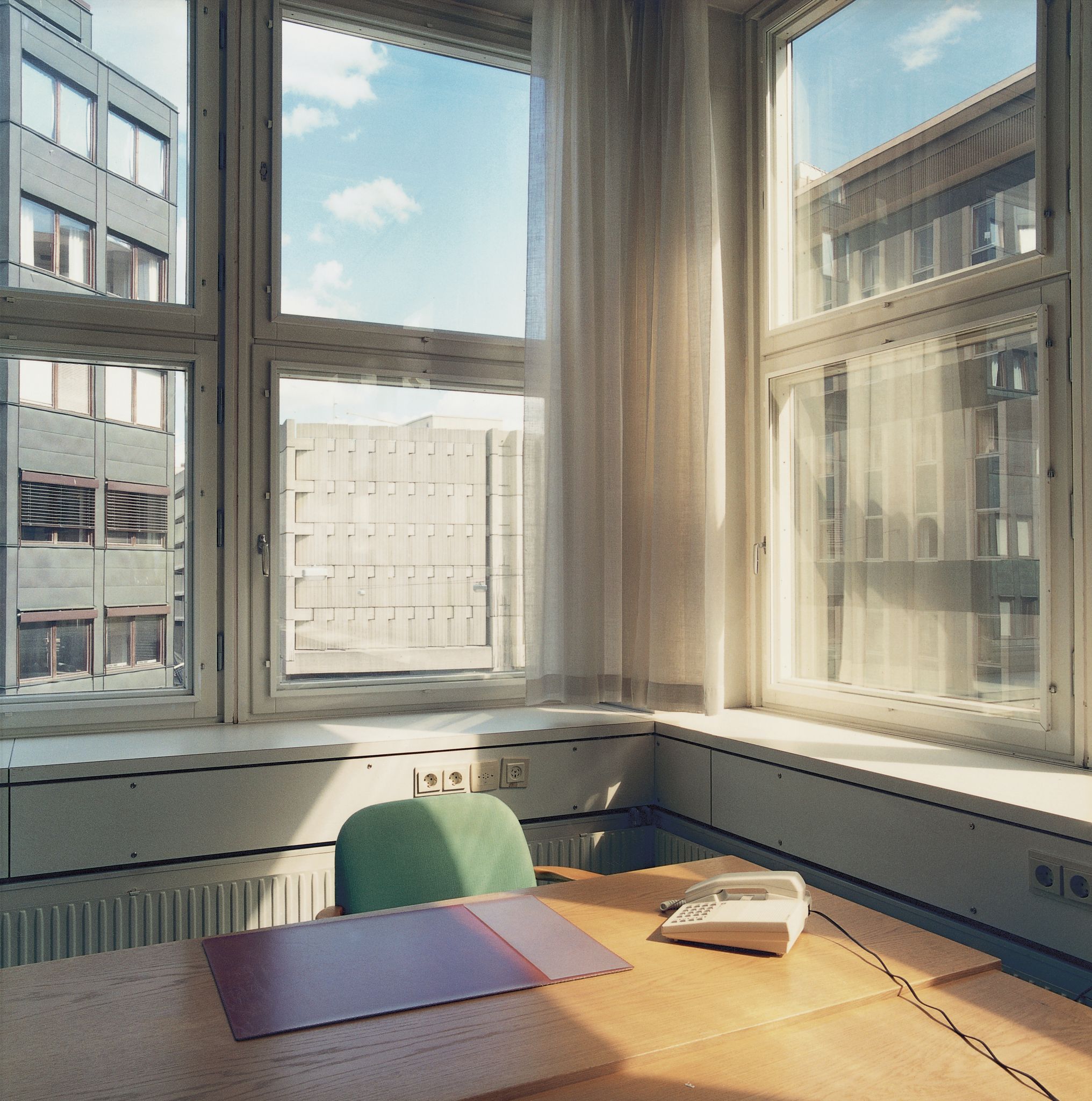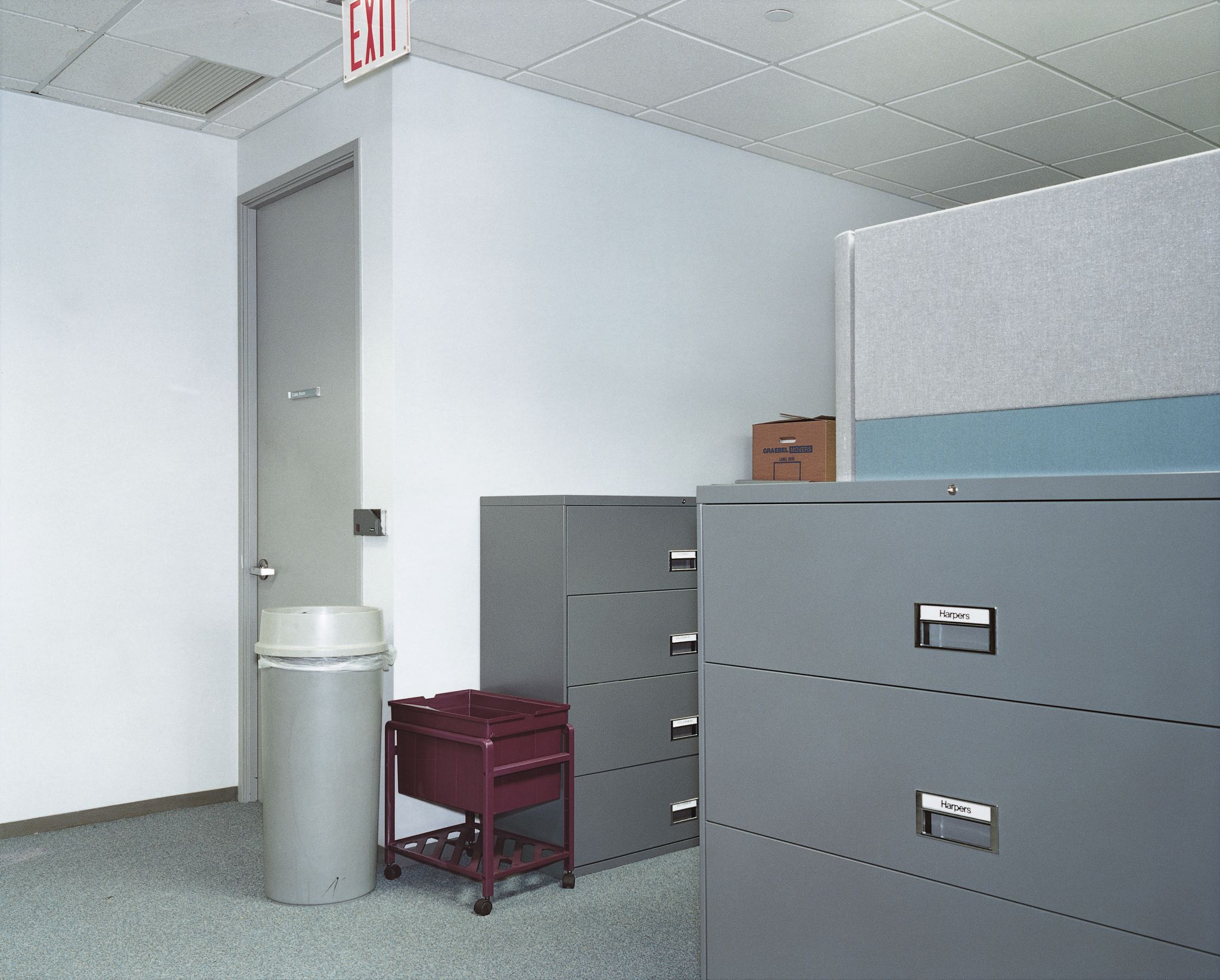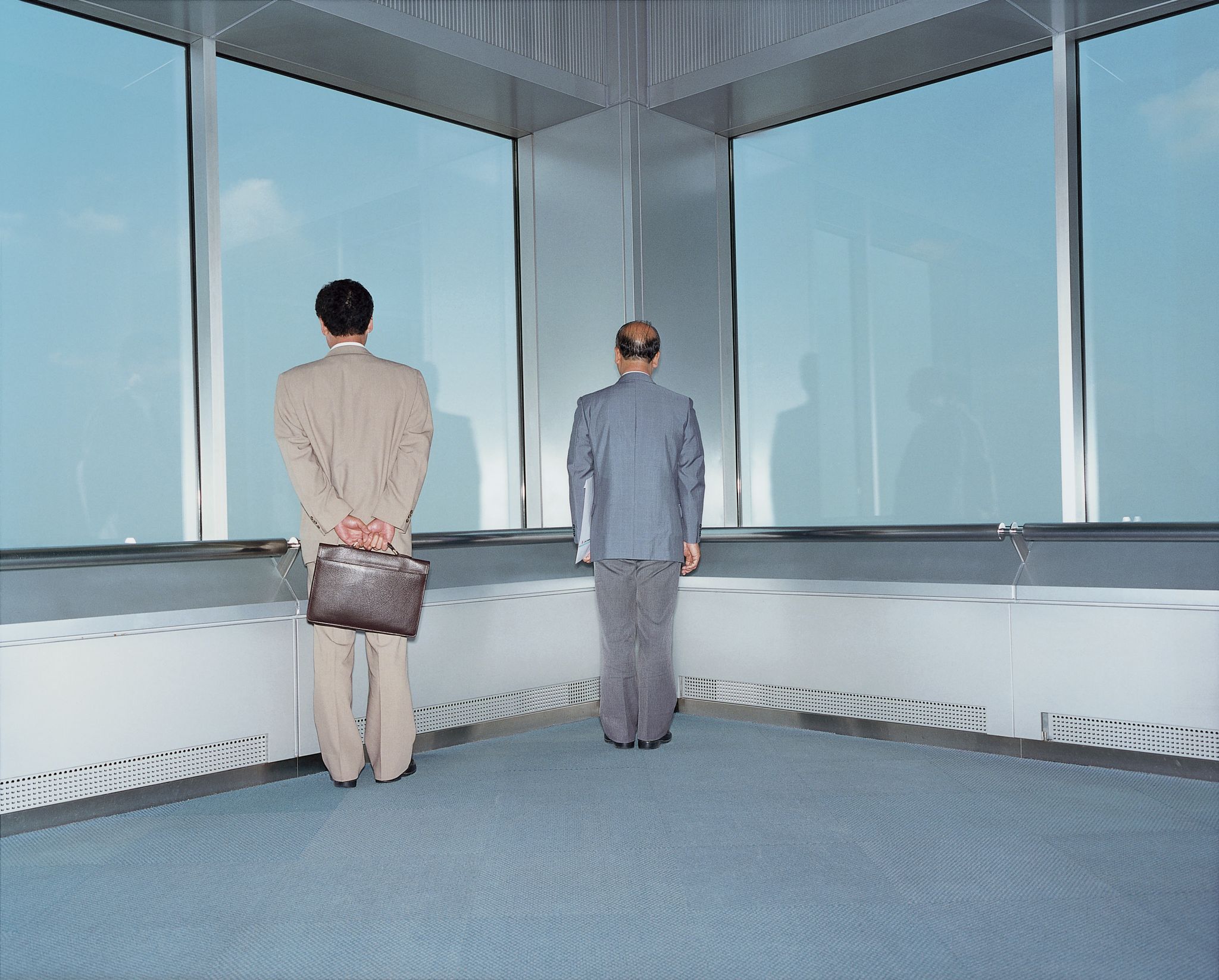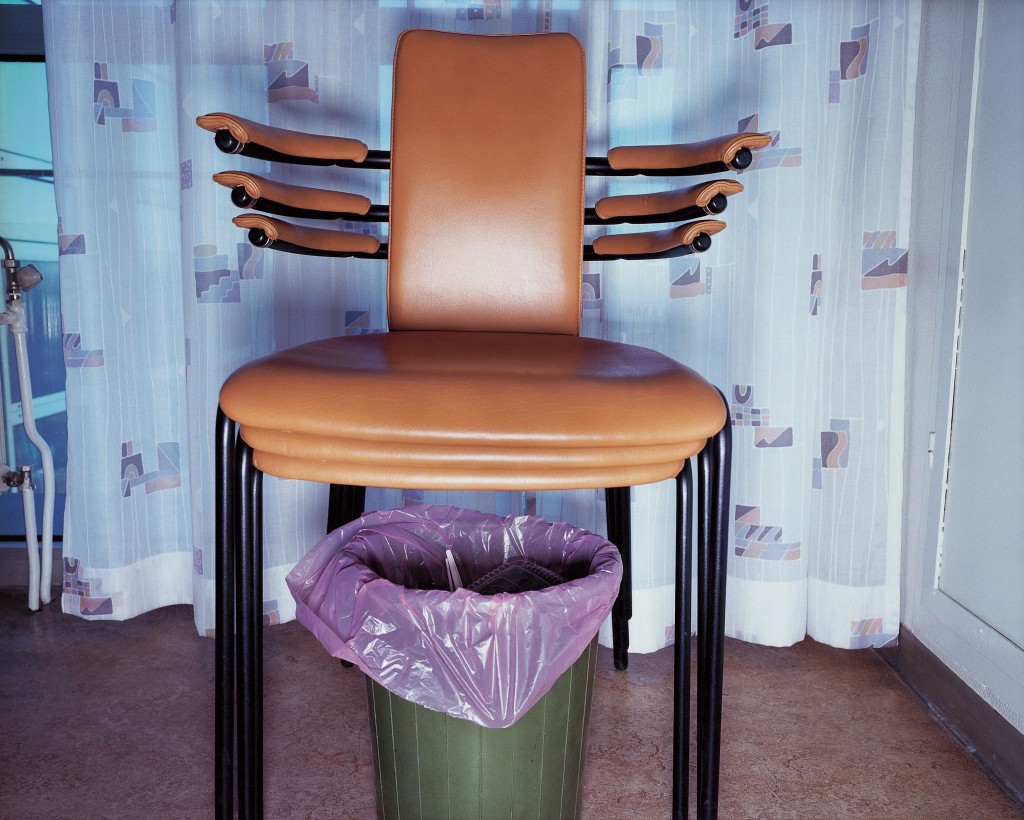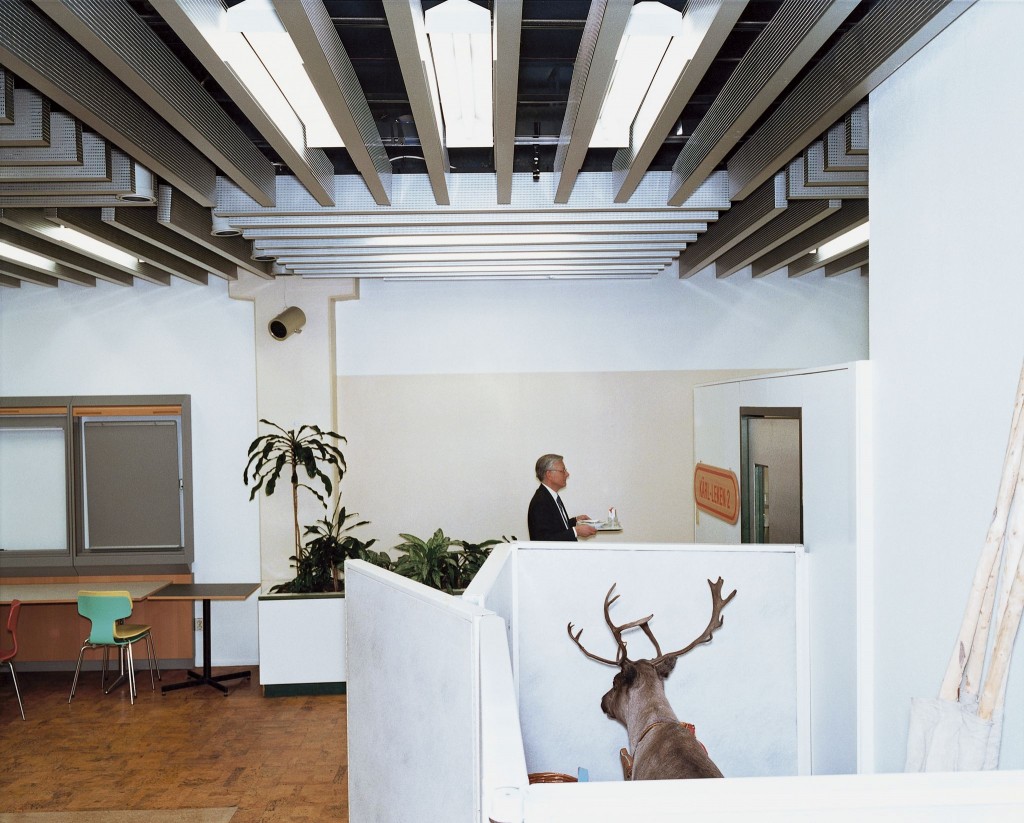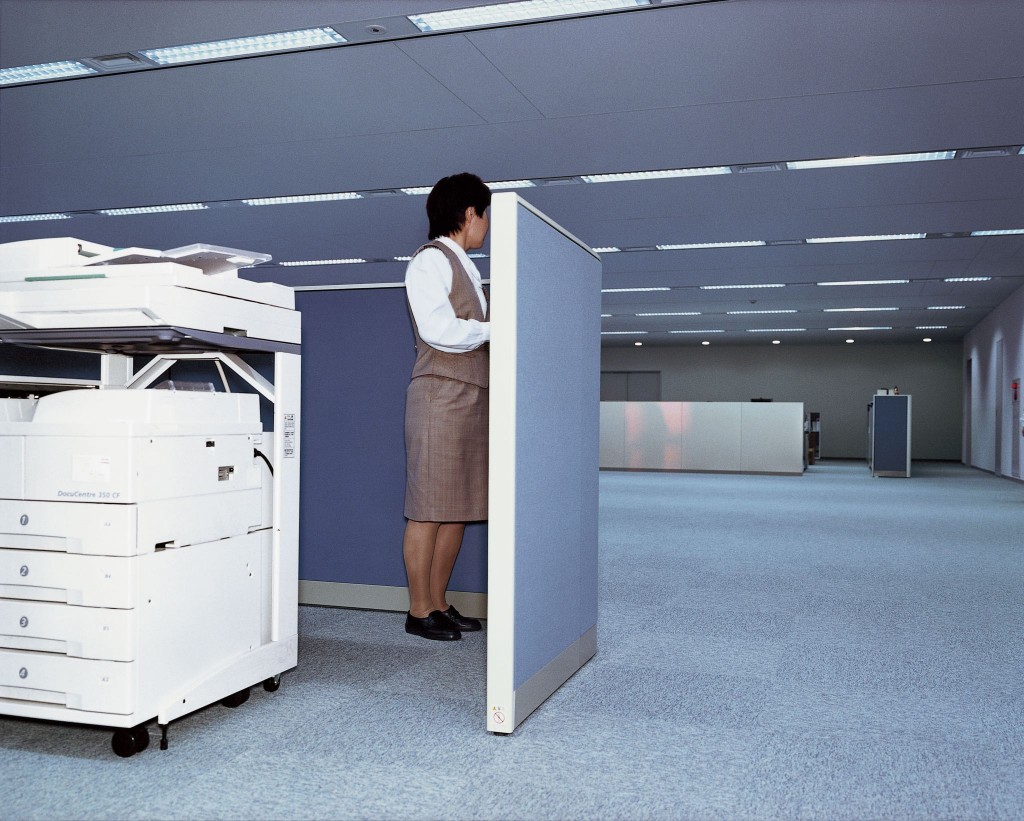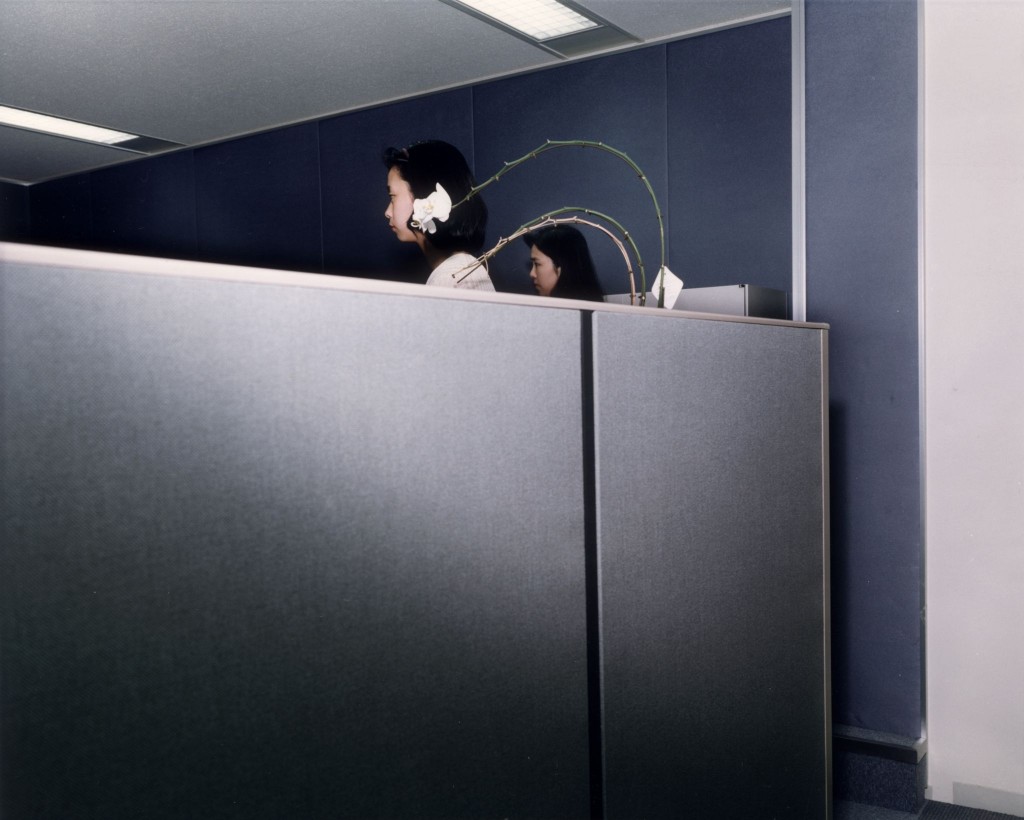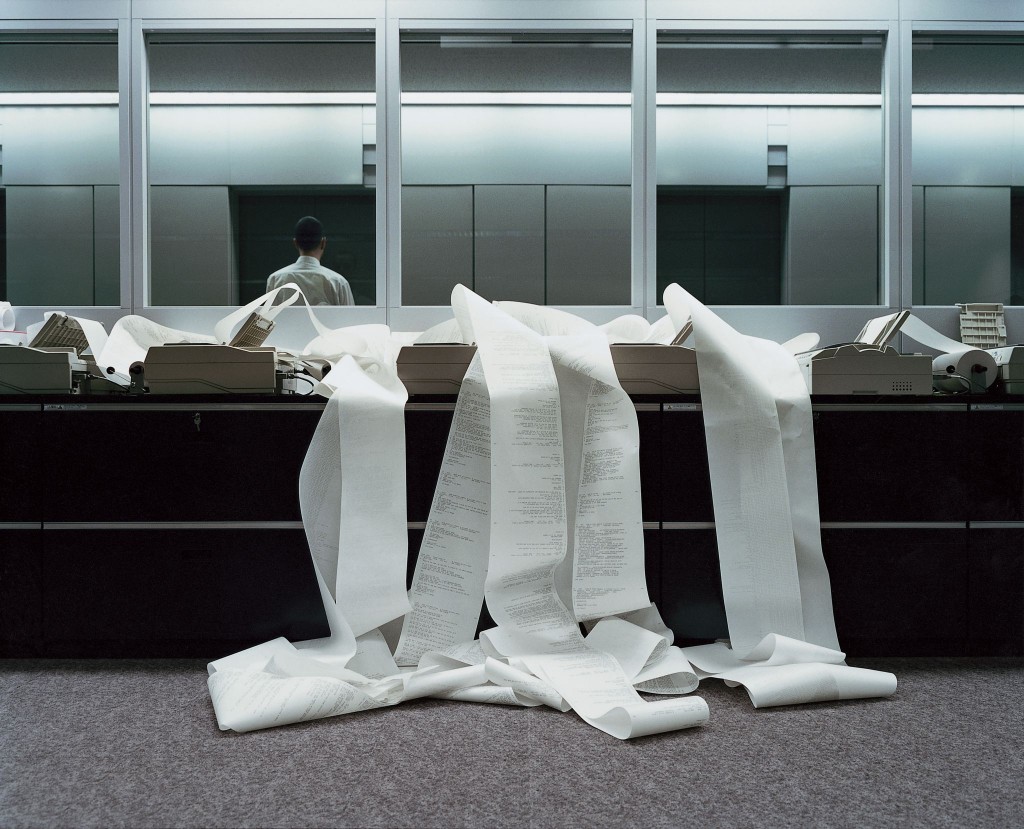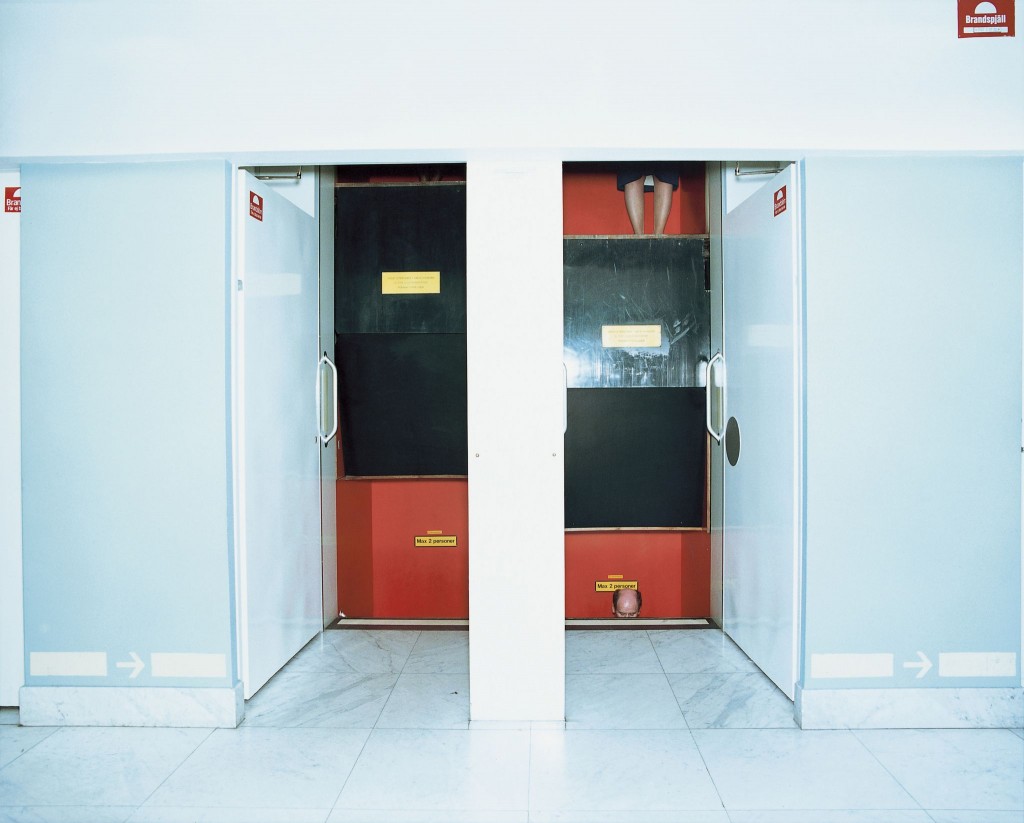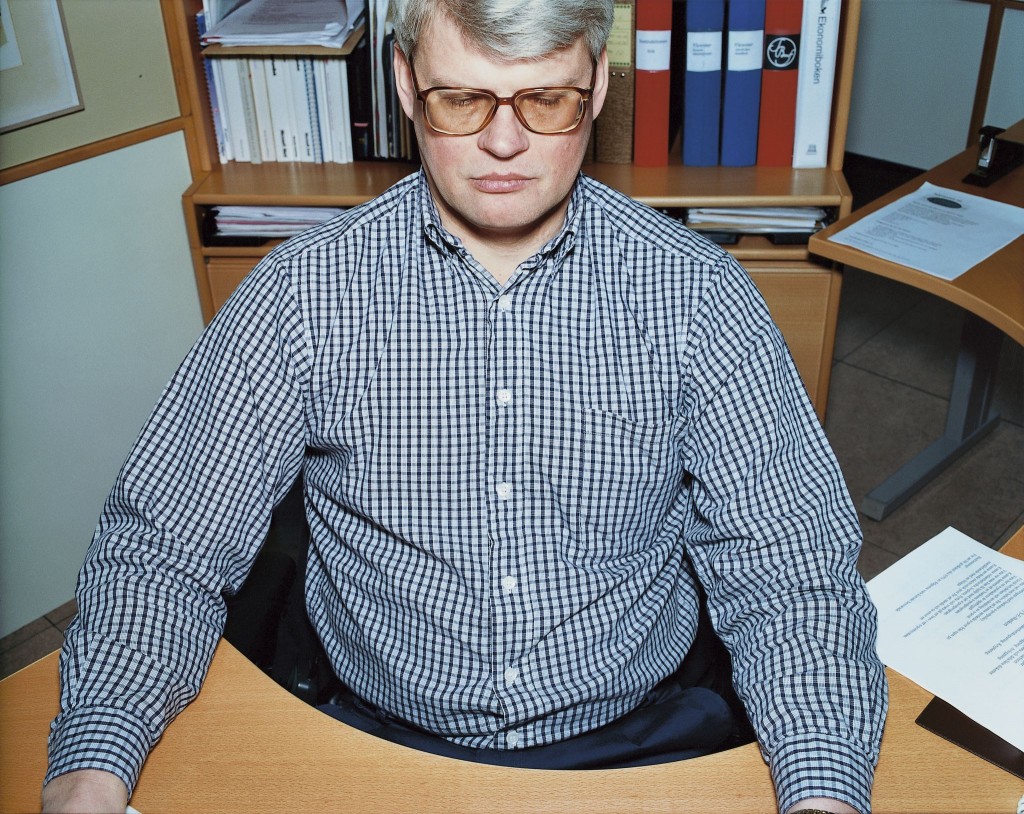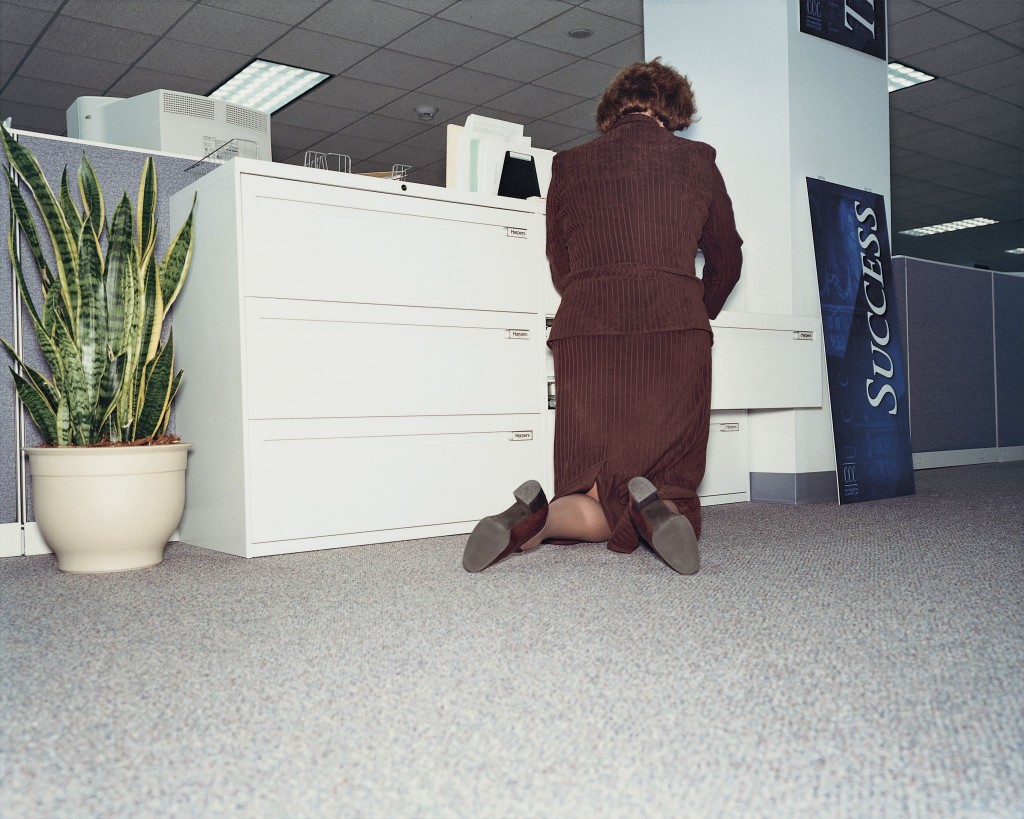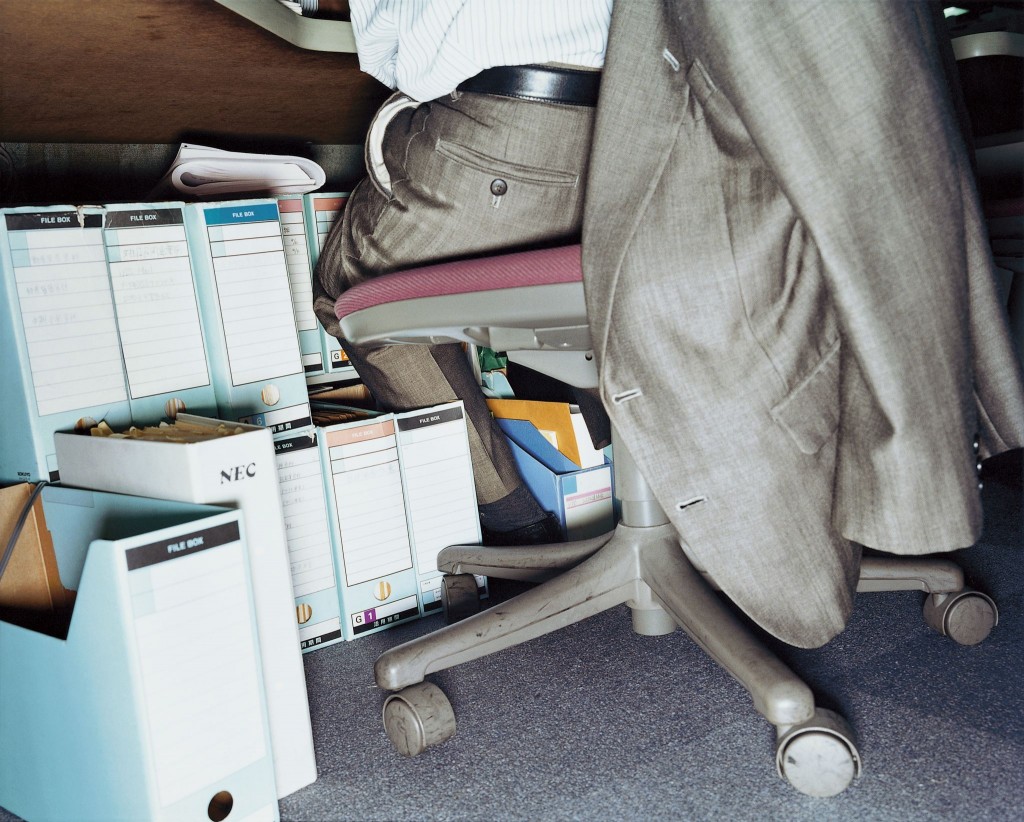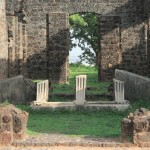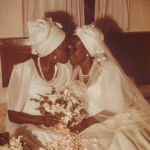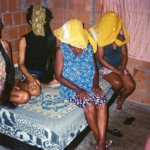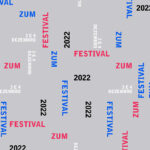A Certain Malaise
Publicado em: 11 de May de 2016The Swedish LARS TUNBJÖRK was a master of colour and irony. In this tribute, ZUM presents the Office series and invites the critic CHRISTIAN CAUJOLLE to review the work and books of the photographer.
The Swedish photographer Lars Tunbjörk (1956-2015) began his career with black and white photography. In the late 1970s and early 80s, he worked for the press, including daily newspapers, which had not yet started printing colour photographs. This professional exercise served as much as a training school in instant photography as a learning experience, as he sought out scenes that he could turn into visual stories. In the small photobook Photography Unbounded (1987), he put together, with humour, images he took at random, a collection of smiles between the fun and the absurd. While many saw them as entertainment, which they certainly were, the way Tunbjörk’s work later developed makes us reflect that the cover illustration of a child restrained in adult clothing that is far too big for him could be a bitter metaphor for a world that is going bad, of a world unsuited to man.
Although, like all Scandinavians, he was influenced by Christer Strömholm, whose work is marked from beginning to end by an obsession of death, Tunbjörk soon became interested in colour. In the early 1980s, in the company of other young people – including one that would remain his friend and accomplice to the end, as well as his best “editor” in the Anglo-Saxon sense of the term, Greger Ulf Nilson –, he had contact with the photography of the USA and came upon, among others, the work of William Eggleston. In Europe at that time, colour photography was limited to the professional studio, to advertising and fashion; press photographers used it for commercial purposes, without changing their approach to composition, which was inherited from black and white. Hardly anyone knew of the Italian Luigi Ghirri, which we now know to have been remarkably creative in this field. But it was American colour that had a powerful influence in this Swede, who adopted it as the starting point for a grammar which was built in an original and profound way until the end.
Throughout his career, Tunbjörk’s commissioned work coexisted with his personal exploration. The two were not contradictory: we might even say that each fed upon the other. In the themes covered by magazines – among them The New York Times Magazine and Géo – he had ideas for the series that he would later on develop, and his permanent exploration of colour, as subject material as well as a way to experiment with light, explains the originality of the tones he used in works for the press, annual reports, company brochures, and advertisements.
The best way to appreciate his contribution to colour photography, and the steps he chose to guide his journey of exploration, is through his books. Especially if we take into account that he was just as demanding and precise in his publications as he was in mounting his exhibitions – he rejected easy and decorative effects, profoundly questioning the real meaning of things, and the overused and irrelevant concept of the “theme”, concentrating instead on questions that appeared essential to him. On one hand, the possibilities of photography and, on the other, the challenges of the world which he confronted without complacency or illusion. Few contemporary photographers have devoted so much time to decipher the territory and issues of their own country.
And so Sweden is the subject of his first colour book: Country Beside Itself: Photos of Sweden (1993), dedicated to a strange, apparently joyful journey, peppered with oddities, surprises, implausible scenes. On a sunny day, Santa Claus watches children playing with little go-karts, and they are soon replaced by a very old adult; a nudist, daydreaming, leaning against her bronze-coloured motorhome on a campsite; a picnic by the water turns into a compulsory bath; a couple on a newly-mowed lawn, protected by two identical yellow sunshades, whose elements seem completely dissociated but are in fact clones; each image, captured individually, is in fact fun, absurd, grotesque. The set of photos becomes slightly unsettling. It is already possible to see the critical viewpoint, which will grow in the face of a society that appears to have such an entirely superficial view of happiness and comfort. In this series, certain compositional elements are combined in a masterful way – the balance, or imbalance, between the coloured masses that form the image. The perspective, emphasising the background and scrutinizing the vanishing points, allows him to show unlikeness – a windsurfer on the side of the road – and to convey the feeling that what matters is not the actual scene, but what the photographer has chosen to include in the image.
The series Office (2002) is the only one that drags us around the world, from Japan to the United States and Germany, without forgetting, of course, Sweden. It was this work that attracted the most attention. In it, he masterfully managed to marry apocalyptic scenes of office life with an exploration of the work spaces, from the time before anyone arrives until the moment the staff start working. Empty, with their “neutral” carpets, their “open” spaces, their “movable” divisions, the spaces turn out to be eery, not uncommonly like prisons. Taken, cluttered, they become spaces somewhere between a nightmare and a guffaw. The secretary lost in a sea of paper scattered on the floor or perched on her desk, or even on her knees in search of the lost document; computer cabinets exposing tangled cords; tons of paper spat out by printers; a creepy orchid supposedly there to brighten up the reception area; a pile of caramel-coloured chairs near a green rubbish bin: cold spaces that give the impression of freezing characters, whose sketchy gesture seems definitely broken – depression is not far away. If, however, we forget the terrible cafeteria scenes, the absurdity – the presence of a stuffed reindeer, a tiny space reserved for physical exercises and gym, the ridiculous installation of a mini-golf course – can save us through laughter. And there, squeezed in a cabinet door, the tip of a tie, like an ironic comma, laying out the supreme vanity of this “rational” or “full of good intentions” wish to ensure the comfort and efficiency of the employees.
Of all Tunbjörk’s photographic series, Office has the largest number of – and most diverse – visual stories. It is also the one which marks his coming-of-age phase, due to his subtlety as a colourist through the monochromatic researches, the control of intensity, a rare ability to fix the image in the monochrome and to compose only with colour. Meanwhile, the use of direct flash, which he explored more in his later work, gives a strong sense of artifice to the plants, among other things. In this universe, transposed into images, nothing is “real” anymore, everything becomes fake and – when the frame is already a chaotic image – a pretext to be captured by the photographer, who can make us forget that it is his own and ruthless views that impose a vision upon us. In Office, Tunbjörk demonstrates his increasing command of framing, locating himself physically in the scene no longer to conceive fake images by overlapping planes, as he began with, but to find the appropriate, precise distance for what he intends to focus on and what he wants us to feel. Carpets covering the walls with their sad colours, elevators whose transparency invents headless characters, obstructed corridors, plastic plants to brighten office work up – make it bearable? –, but also individuals immersed in their computer screens: everything is distressing. From close-ups to rooms where the receding lines do not meet, Tunbjörk creates a feeling of malaise, discreetly but with a terrible efficiency. Especially as he crops the space with rare precision, which can be perceived in the angles, exploring it with a scalpel, refusing its evidence and inconsistencies and revealing the extent to which it is inadequate.
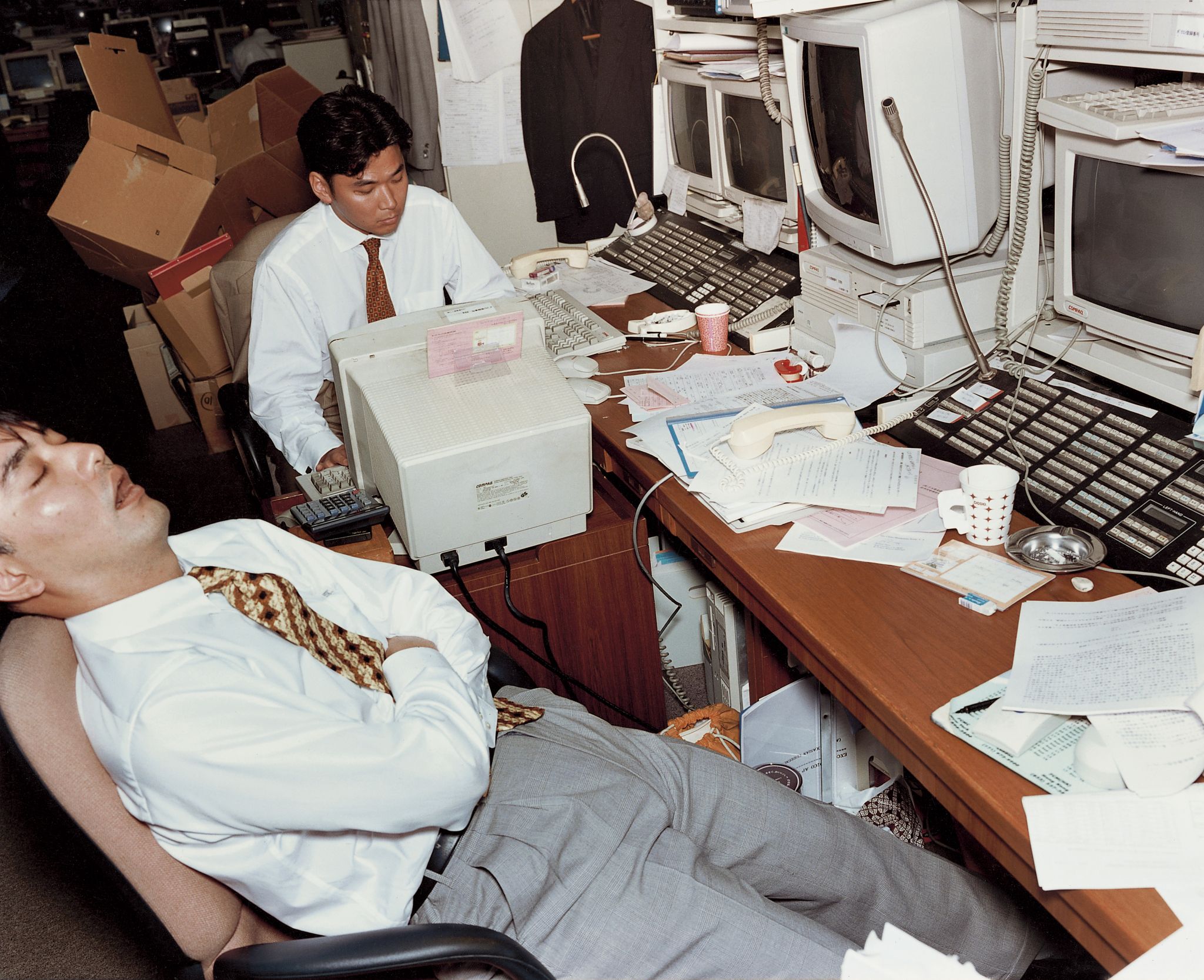
Japan, 1996
Less spectacular, but even more anguished, the series Home (2003) takes us back to Sweden, to condominiums, to the “comfortable” houses of the petty bourgeoisie, who care for their gardens obsessively – and here, too, under the flash effect, the plants appear artificial –, who cultivate repetitions of conventional good taste, who love roundabouts because they are safer for the driver, and the whole Ikea culture that Lars never derides – he was not a nasty person – but which makes him distraught for its untruthfully inoffensive banality. It is in this dead-end, repetitive world, where some dogs seem lost, that we sadly wonder about the future of the few children to be seen, prematurely aged in their drab clothes. A distressing vision, where criticism is veiled behind the disillusioned observation, this series is also where the photographer shows more finesse and variation in his work, a dialectic between the inside and the outside. From the viewpoint of colour, the faded tones – many browns, ochres, some purplish dots on the inside, washedout or intense greens, as well as pale yellow and red tones on the outside – do not avoid a feeling of weariness, a sensation which increases throughout the pages, to be succeeded by an infinite sense of sadness.
The last two books published by Tunbjörk while he lived – shortly before he died the photographer was preparing a big monograph – are masterpieces and can be seen as a mixture of both testament and manifesto. I Love Boras, published in 2007 and bearing the name of the city where the photographer was born, is a compilation of 175 photographs taken over the years, the returns, the visits to the family. Bolder, more colourful than the others, the book is often marked by an excess of magenta and plastered with signs. It is a terrifying panorama of the ordinary consumerism, ubiquitous, organised, which snatches and carries away the bodies, turning everything into a commodity that it accumulates. Visits to supermarkets, always a sacrifice, become frightening when the sales are on and even worse when the end of the year celebrations are getting close. The shelves crammed with food, charcuterie and chocolates – photographically, they appear the same – soon make us feel queasy, and as we move on through scenes populated by surreal characters, parties lubricated with a lot of alcohol, bleak visions of petrol stations and cul-de-sacs, we want to run away. The framing becomes more surgical, without escape, in favour of quite often crowded scenes, as consumerism demands. When eventually the photographer chooses to widen his field of view, he comes across characters lost near their cars, on the grass next to the forest, or poor devils pushing their grocery carts in a parking lot. Needless to say, Tunbjörk, settling the account with consumerism, was not named citizen of honour in his hometown.

France, 1999
Published in the same year, Winter dramatically changes its tone. Not in essence, but in form. The result of years of work during the endless winters in Scandinavia – those which deprive the inhabitants of light, who take refuge in alcohol, and the photographers, for whom light is vital –, the series conveys its delicacy in a rare palette, simultaneously subtle and dirty. The snow is never white, but always grimy, even when someone draws eyes and mouths with black paint on a snowman, which could make us smile but cannot expel the profound, heavy sorrow of those dark months. Dogs guard building doorways with glittering eyes; the children’s playgrounds are pure desolation; the plants are wilted, trapped under the ice, half rotten; and indoors, in the bars and restaurants, under the planned, cold lighting, people try to believe that they are having fun with fake noses and the tawdry accessories of the dance floor. Characters, caught in the flash burst, emerge out of the shadows, each more terrifying than the other, regardless of their age; boredom looks set to overcome appearances, frivolity is everywhere, suffocating, desperate.
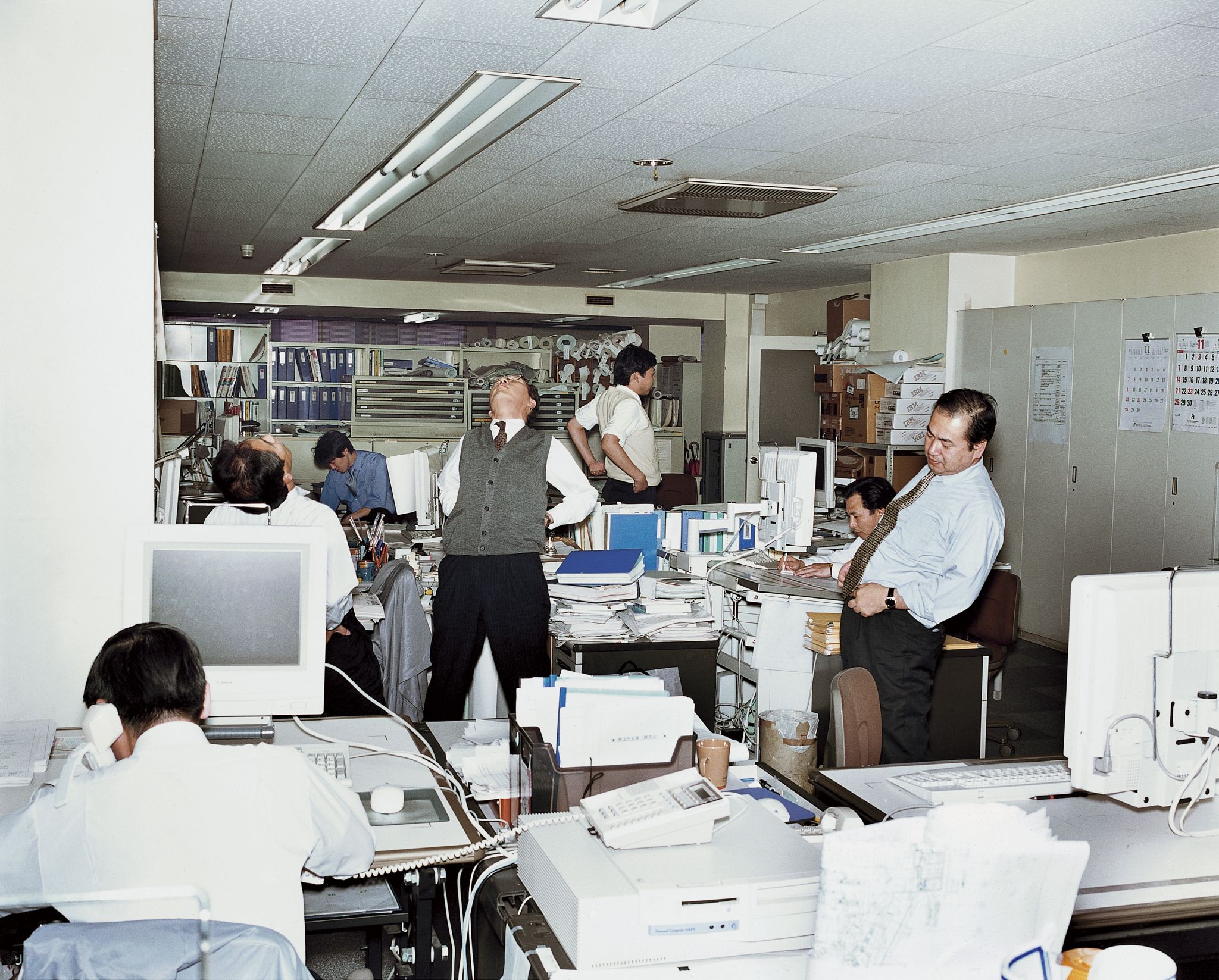
Japan, 1999
It is by comparing these two last works that we are able to understand Tunbjörk’s contribution to the use of colour in photography, which extends beyond his coherent and confident approach to the themes. We should pay attention to the relevance of his choice of colours, as all his compositions are based on their formal organization, the way they will be known, received, amplified, attenuated, detailing light and recording the elements of the world in three dimensions within the square or rectangle of the frame. The silky, exuberant, superficial, inveigling tones of I Love Boras contrast with the sophistication and the shades of colours chosen for Winter. It is enough to examine the tonality of red in both books: it is totally different in nature. It is not a visual story, but an impressive desire to accurately delimit the overall sense, the expression, the correction of the viewpoint. Therefore, the use or not of flash in ambient light, directing it to a specific point or illuminating the whole scene, is not a technical choice, but, as Tunbjörk used to say, a political decision to be evaluated rigorously.
During Tunbjörk’s exhibitions, the script was always the same. The visitors came in, laughed and smiled, delighted with the absurd anecdotes they discovered in each image. They amused themselves with those little slices of extravagant, unexpected life. However, as they continued round the exhibition, they became more circumspect, doubting. Most visitors ended up depressed by the accumulation of aberrations seen which they related to a contemporary reality, also shared by themselves.
Unquestionably one of the great European colour photographers, Tunbjörk is also a critical, beneficial philosopher. One of those who managed to find an original tone to question our reality. To the point of despair.///
images: © Lars Tubbjörk / Agence VU’
+
Gränslösa bilder/ Photography Unbounded (Lucida Pocket, 1987)
Landet Utom Sig: Bilder från Sverige (Journal, 1993)
Kontor/ Office (Journal, 2002)
Home (Steidl, 2003)
I Love Boras (Steidl, 2007)
Vinter (Steidl, 2007)
LARS TUNBJÖRK (1956-2015) was a Swiss photographer and belonged to the French agency VU’. Amongst his many books are Offi ce (Journal Editions, 2002), Home (Steidl, 2003), and Vinter (Steidl, 2007).
CHRISTIAN CAUJOLLE (1953) worked as an art critic and photo editor at the Libération newspaper until 1986, when he founded the photographers’ agency VU’. He is the author of books on the work of Jacques Henri Lartigue, William Klein, Anders Petersen, Raymond Depardon, Isabel Muñoz, Christer Strömholm, among others.
///
Get to know ZUM’s issues | See other highlights from ZUM #10 | Buy this issue


